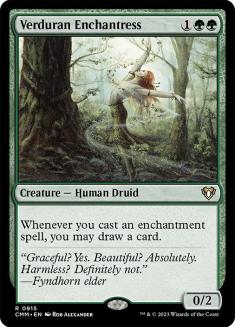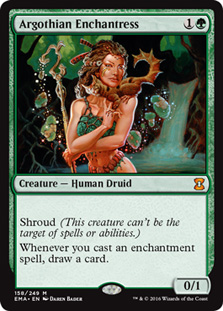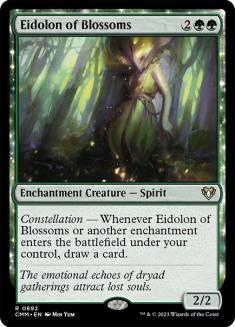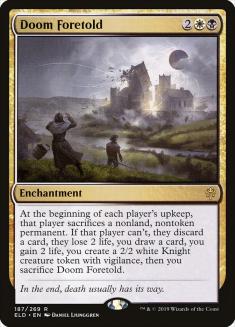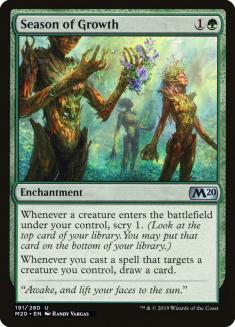It’s that time again, gamers! Theros Beyond Death is just around the corner, and I couldn’t be more ready for it. Throne of Eldraine burst its way into the format like a lion, but as time went on it proved itself to be more like… well, a lion hopped up on a cocktail of Venom, Super Soldier serum, and sheer unadulterated hate for all things decent in the game of Magic. The past few months have been rough, but perhaps Theros Beyond Death is the first step on the road to recovery.
Throne of Eldraine‘s power level does rehash an old preview season conundrum, though. Exactly how much deckbuilding are we supposed to be doing at this stage? After all, we know the barrier to entry in this new Standard will be extremely high. Simic decks remain powerful, Teferi lingers in the background, Fires of Invention is still producing obscene amounts of mana, and Witch’s Oven plus Cauldron Familiar is a late-game that’s good enough for Pioneer play. Given these factors, is it worth going deep on the new cards which, thus far, seem just a step behind?
The short answer is yes. The long answer has a lot to do with goals in deckbuilding. We tend to evaluate deckbuilding based only on its output: if I built a good deck, then the effort was worth it; otherwise, I failed. This is extremely shortsighted, and a dichotomy you must abandon if you want to grow as a deckbuilder. Failed experiments are crucial for understanding pressure points in the metagame, and for identifying key interactions worth banking for inclusion with future technology.
During the Throne of Eldraine preview season, I spent lots of time on Mono-Black Araya decks. These decks proved to be lacking, but they forced me to start taking Witch’s Oven plus Cauldron Familiar seriously. At the same time, their vulnerability to Oko alerted me to a future problem in waiting. None of my Mono-Black decks were ever played in a tournament, but the lessons learned while building them directly impacted my deckbuilding and selection in what was a very successful first two weeks of the new format.
All in all, I built close to 70 decks before Throne of Eldraine even released. I intend to approach deckbuilding for Theros Beyond Death with the same vigor. I will build to maximize cards within format constraints rather than just immediately conceding that a card isn’t good enough. In doing so, I am not attempting to build the best deck. I’m laying the foundation that will eventually allow me to build the best deck.
Here’s our first brick:

“Enchantresses” or creatures that draw a card when you play an enchantment have been around Magic since literal Alpha.
Certainly, time has been less than kind to this approach to the game. Eidolon of Blossoms turned the corner a bit by providing immediate value upon entering the battlefield and scaling super-well in multiples. Argothian Enchantress had a method of self-preservation in shroud, as well as a reduced mana cost.
With Setessan Champion, though, we’re back to a three-mana creature which must survive in order to impact the game. When you could just have a Teferi or Narset instead, it’s hard to justify the investment in a card like Setessan Champion. However, Le Champion has a couple of things going for it. The first feather in its cap is that size matters in present-day Standard. Removal often focuses on a creature’s toughness, and Setessan Champion can get really big, really quickly. Second, a return to Theros means enchantments will be extremely plentiful and capable of doing things we never expected an enchantment to do.
Without further ado, I give you my top four enchantments I can’t wait to play with Setessan Champion.
4. Improbable Alliance
Improbable Alliance has been one of my pitfall cards since it has been released. It’s almost always appearing in a Wilderness Reclamation shell, and I’ve talked at length about how poor I think that strategy is in present Standard. Perhaps this is finally the time to take a whole new approach to the card.
Creatures (10)
Planeswalkers (2)
Lands (25)
Spells (23)

We’re pretending a lot of cards don’t exist by building the deck in this fashion (chiefly, Narset) but I like how well the pieces lock together. Virtually every card in the deck assures your Improbable Alliances and Irencrag Pyromancers will do their thing. Setessan Champion looks odd paired up with only twelve enchantments, but with Flood of Tears in the mix it’s going to set up some incredible reload turns and be able to end the game in a hurry after they occur.
Survival and then explosion is the name of the game. The often X/4 sizing of your creatures contrasted against the Elks created by Kenrith’s Transformation is just too cute. There’s no way you can convince me these cards weren’t destined to be played together.
3. Doom Foretold
Doom Foretold felt like exactly the kind of deck that was missing a secondary value engine. If opponents successfully answered Doom Foretold or set themselves up to play a long game in a fashion that ignored the card, they could eventually cobble together the means to kill you over a game that was sure to last twenty-plus turns. With Setessan Champion, it’s possible we can shrink the game to a length where Doom Foretold can always effectively blunt opposing offense.
Creatures (7)
Planeswalkers (3)
Lands (25)
Spells (25)

We’re carrying over some of the same tricks from our last deck. Maybe I’m completely crazy for thinking that Kenrith’s Transformation is a Constructed-playable card, but I’m a big fan of things that play temporary defense in Doom Foretold decks. I used to see Prison Realm as a non-bo with Doom Foretold, but now I realize that sacrificing your Prison Realm will often only force your opponent to waste yet another turn sacrificing to Doom Foretold. If you ever have a Setessan Champion on the battlefield, it should be trivial to fuel your namesake card until your opponent crumbles under its weight.
Elspeth, Sun’s Nemesis seems to have folks split right now, but you can put me in the camp that believes this card to be incredible, particularly in an attrition-based deck like this one. It excels at putting your opponents in the “squeeze.” Are you committing resources to denying me max value from Elspeth, or are you content to watch me repeatedly generate four blockers? The first Elspeth seems manageable. The second and third one will just kill your opponent. I have no doubt that this midrange style of enchantment deck will receive tons of new prints in Theros Beyond Death, and I expect to return to this build repeatedly over the coming weeks.
2. Season of Growth
1. Staggering Insight
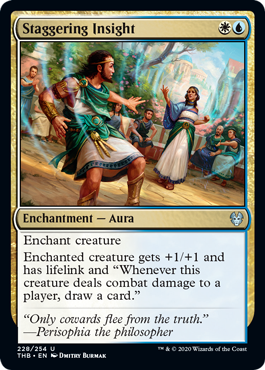
This is what we’re really here for. Setessan Champion is going to be most at home when it is getting opponents dead. Season of Growth, Staggering Insight, and Setessan Champion working together represent an incredible amount of card advantage for a deck that is going to be capable of some serious goldfish speed. My first pass:
Creatures (18)
- 2 Paradise Druid
- 3 Barkhide Troll
- 4 Gilded Goose
- 1 Brazen Borrower
- 4 Setessan Champion
- 4 Eidolon of Philosophy
Lands (22)
Spells (20)

The mana here is rough, and I don’t know if we can tolerate the lack of a truly safe vessel, but I anticipate Gilded Goose might just be the answer to both problems. The evasive body should pay big dividends when you move all-in on Turn 2 Staggering Insight. I’d expect weak enchantments like Glaring Aegis to hit the bench as better cards from Theros Beyond Death are revealed.
The idea of safe threats just might be outdated, given how capable this deck is at rebuilding from almost nothing. A strong set of enchantment creatures rounding out the threat base will likely do away with the need for cards like Barkhide Troll due to their ability to generate card advantage through Setessan Champion. As for the Champ itself, if you’re trying to race an opponent, I suspect it will get the job done in many scenarios, especially if it picks up the lifelink from Staggering Insight. What can a deck like Mono-Red do against a Setessan Champion if it isn’t killed on sight?
All these decks seem reasonable in their current states, and that is exciting news with an entire set loaded with enchantments yet to be revealed. However, it will take a lot to overcome Throne of Eldraine‘s power level, and beyond that, there are cards like Noxious Grasp lying in wait for Setessan Champion.
The solution seems to be in taxing removal, and presenting your opponent with multiple layers of redundant, must-answer threats or value engines. In addition, you are incentivized to accomplish this by cobbling small spells together to effectively play around countermagic from decks like Simic Flash and its successors. When your plan comes together, it must outscale the late-game of Cauldron Familiar / Witch’s Oven or contain an acceptable way to break up the combo. This is a lot to ask from deckbuilders, but by starting early we can start to hypothesize about the tools that are up to the challenge.

